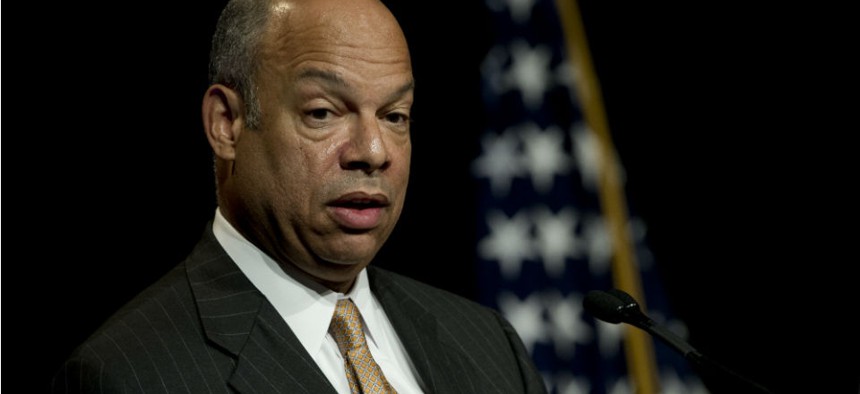
Homeland Security Secretary Jeh Johnson said much of illegal migration is seasonal. U.S. Navy Petty Officer 1st Class Chad J. McNeeley/Defense Department file photo
Far Fewer Unaccompanied Minors Are Now Crossing the U.S. Border
That doesn't mean the crisis is over.
The rush of unaccompanied children crossing the U.S.-Mexico border slowed in September to the lowest number of monthly apprehensions since January 2013, just two months after the crisis hijacked much of July's congressional session.
In September, 2,424 unaccompanied minors crossed the border, which is 8,000 less than the surge in May and June, according to Homeland Security Department data. Though these figures may sound encouraging, it doesn't mean the problem is permanently solved, advocates and administration officials say.
Originally, DHS officials estimated that about 60,000 unaccompanied minors would illegally enter the country by Sept. 30. But that projection increased to 90,000 during the summer—a change attributed to children fleeing escalating violence, gang recruitment, and economic disparities plaguing Central America's Northern Triangle. The actual total was about 68,500, according to the newly released data.
But, DHS Secretary Jeh Johnson warned, what officials called a "border crisis" over the summer isn't over.
"Much of illegal migration is seasonal," Johnson said Thursday at the Center for Strategic and International Studies. "The spike in migration we saw this summer could return. The poverty and violence that are push factors in Honduras, Guatemala, and El Salvador still exist."
Wendy Young, Kids in Need of Defense executive director, said the cycle of migration could certainly contribute. But there's another factor at play here: the number of kids being intercepted by Mexico or other countries' governments before actually making it to the United States.
"That's concerning to me," Young said, "because it's not that other countries don't have the right and representatives to control their own borders, but I think there are very, very serious concerns about if the kids are accurately screened for protection before they're repatriated."
At the crisis's peak, 10,622 unaccompanied children were apprehended at the border in June. This uptick spurred President Obama to ask Congress in July for $3.7 billion in emergency funds, which went unappropriated.
But there was a response, albeit much smaller: More detention space was built in New Mexico and Texas. Hundreds of border-patrol agents were assigned to the Rio Grande Valley sector. Media campaigns were launched in Central America, highlighting the dangers of letting criminal smuggling organizations lead children on a journey to the border, according to Johnson.
To discourage this trek, Obama approved a plan last month permitting several thousand children to apply for refugee status, The New York Times reported.
"We are establishing in-country refugee processing to provide a safe, legal and orderly alternative to the dangerous journey that children are currently undertaking to join relatives in the United States," Shawn Turner, a spokesman for the White House, told the newspaper. "These programs will not be a pathway for children to join undocumented relatives in the United States."
The administration also plans to provide $9 million over the next two years in legal services to 2,600 children who crossed the border alone, according to The Washington Post. It's not uncommon for children to be left alone to navigate the legal system, as there aren't enough pro bono attorneys to take up every case.
But none of these actions address the root causes of the influx earlier this year.
"I think that we really are at the same place we were when this whole crisis broke in May," Young said, "which is we do have a problem and the problem is that Central America is becoming increasingly violent and people are becoming refugees, so we need to be looking at comprehensive solutions."
With the help of the Inter-American Development Bank, officials from El Salvador, Guatemala, and Honduras crafted the Plan of the Alliance for Prosperity in the Northern Triangle to strengthen the region, according to Honduran Minister for Foreign Affairs Mireya Agüero de Corrales. Their roadmap for change was given to Secretary of State John Kerry last month, and the minister told National Journal she's hoping for a response in mid-November. While the plan doesn't ask for a specific dollar figure, she said the hope is $300 million would be appropriated—which is the amount Obama's emergency supplemental would have spent in the region.
"I think it's historical that we have a plan," she told National Journal. "It's historical that the three countries have agreed to the terms of this."
She told an audience at a Congressional Hispanic Caucus Institute panel last week her fear: "One of the risks I see here after the crisis is that we forget the crisis."







